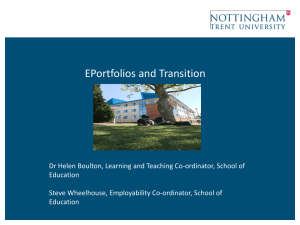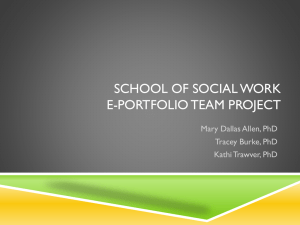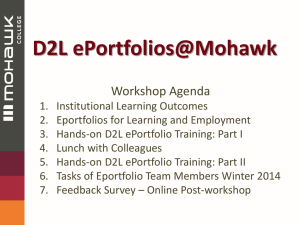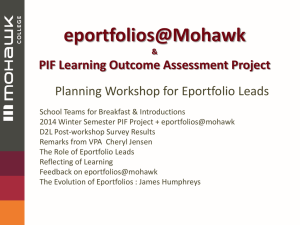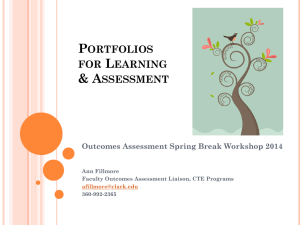Documenting Learning with ePortfolios
advertisement
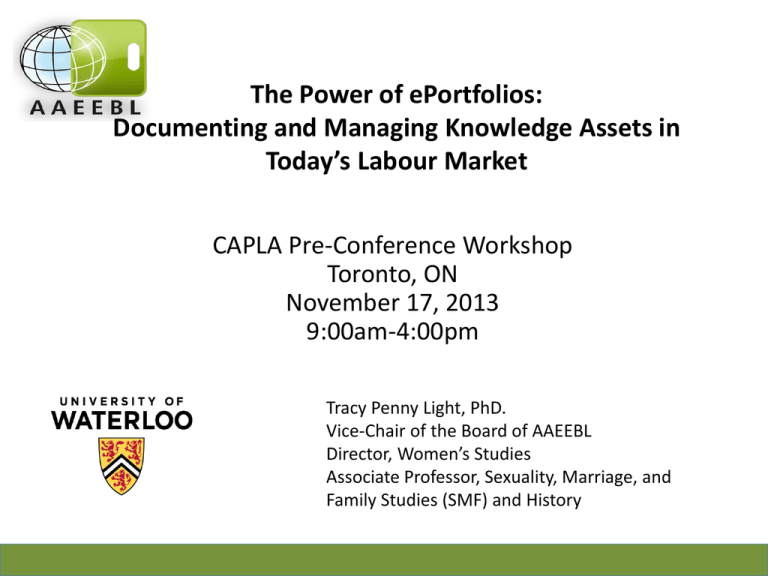
The Power of ePortfolios: Documenting and Managing Knowledge Assets in Today’s Labour Market CAPLA Pre-Conference Workshop Toronto, ON November 17, 2013 9:00am-4:00pm Tracy Penny Light, PhD. Vice-Chair of the Board of AAEEBL Director, Women’s Studies Associate Professor, Sexuality, Marriage, and Family Studies (SMF) and History Today’s Overview This Morning: • Introductions and Icebreaker • Documenting Learning with ePortfolios: An Overview This Afternoon: • ePortfolios and Advising/Mentoring • Planning for Implementation in Your Context: Using a Logic Model • Introducing AAEEBL and the ePortfolio Community • Questions Take-Home Messages • ePortfolios can be used for multiple purposes to engage a variety of stakeholders; • ePortfolios allow users to collect, select, and present authentic evidence of/for learning in many contexts for a variety of purposes; • ePortfolios are all about the PROCESS, therefore, it is essential to plan your implementation and activities around the OUTCOMES you wish to achieve with your STAKEHOLDERS What are ePortfolios? Electronic portfolios (ePortfolios) are collections of digitally represented artifacts that: • document practice • include reflection • integrate experience • map to goals and/or standards • promote deep learning and knowledge transfer Documenting Learning with ePortfolios Why Document Learning with ePortfolios? • New technologies pushing boundaries for learners ▫ Globalized world, information is everywhere • Increasing need for documentation of competencies and skills ▫ Learners need to learn ways to assess what it is that they know, understand and are able to do • Rapidly changing context requires integration abilities ▫ ePortfolios provide opportunities for learners to reflect on, identify, organize, and describe their lifelong and life-wide learning = DIGITAL IDENTITY (LinkedIn) • Need ways to help learners to “make connections” and demonstrate their knowledge ▫ Reflection and Action! Folio Thinking: Reflection for Learning •Reflection is what makes us learners; we need to practice, assess and perfect it. •Four criteria characterize the concept of reflection: ▫ Reflection is a meaning making process ▫ Reflection is systematic, rigorous and disciplined; with roots in scientific inquiry ▫ Reflection needs to happen in community ▫ Reflection requires attitudes that value personal and intellectual growth From: Carol Rodgers, “Defining Reflection: Another Look at John Dewey and Reflective Thinking,” Teachers College Record, 104, 4 (June 2002): 842-866 A Taxonomy of Reflection A Taxonomy of Reflection Creating: What should I do next? Evaluating: How well did I do? Analyzing: Do I see patterns in what I did? Applying: Where could I use this again? Understanding: What was important about it? Remembering: What did I do? Model Developed by Peter Pappas ePortfolio Implementation Framework (Chen & Penny-Light, 2010; Penny-Light, Chen, & Ittelson, 2012) • Defining Learning Outcomes • Identifying & Understanding Learners and Stakeholders • Designing Learning Activities • Informing Assessment of Student Learning • Using ePortfolio Tools and Technologies • Evaluating the Impact of Your http://www.documentinglearning.com ePortfolio Initiative Identifying and Understanding Learners and Stakeholders • Who are we designing the learning experience for? • What are their characteristics? • What technologies are they comfortable with? • What support will they need to create their ePortfolios? How does being continually connected affect how students interact with each other and how they experience college? http://chronicle.com/article/Bleary-Eyed-Students-Cant/129838/ What’s being lost in this environment? “We are being pummeled by a deluge of data and unless we create time and spaces in which to reflect, we will be left with only our reactions.” --Rebecca Blood, weblog historian • • • • Communication skills (writing and in person) How to think How to be contemplative How to reflect --Chronicle for Higher Education, 10/5/05 • Empathy? --Konrath (2010) Identifying and Understanding Learners and Stakeholders • Who are we designing the learning experience for? • What are their characteristics? • What technologies are they comfortable with? • What support will they need to create their ePortfolios? Sketch… who are the stakeholders for your ePortfolio project. Don’t think too much. Put your pen to paper and start drawing. Artifacts/Evidence in an ePortfolio Identifying User Characteristics: What data already exist? • What methods can we use to learn about our ePortfolio learners? • What existing sources of data are available and accessible? Who owns this data? Brainstorm Strategies to Engage Stakeholders How will you communicate your vision for how ePortfolios can work in your context to your stakeholder of choice? – – – – WHO is your stakeholder? Why does your stakeholder NEED an ePortfolio? How can your stakeholder BENEFIT from the ePortfolio? What can your stakeholder CONTRIBUTE to the ePortfolio? ePortfolio Implementation Framework (Chen & Penny-Light, 2010; Penny-Light, Chen, & Ittelson, 2012) • Defining Learning Outcomes • Identifying & Understanding Learners and Stakeholders • Designing Learning Activities • Informing Assessment of Student Learning • Using ePortfolio Tools and Technologies • Evaluating the Impact of Your http://www.documentinglearning.com ePortfolio Initiative Defining Learning Outcomes • What learning outcomes are you currently implementing or considering for your ePortfolio initiative? • What types of learning do you want to capture and document? Association of American Colleges & Universities, http://www.aacu.org/leap/ 20 21 ePortfolio Implementation Framework (Chen & Penny-Light, 2010; Penny-Light, Chen, & Ittelson, 2012) • Defining Learning Outcomes • Identifying & Understanding Learners and Stakeholders • Designing Learning Activities • Informing Assessment of Student Learning • Using ePortfolio Tools and Technologies • Evaluating the Impact of Your http://www.documentinglearning.com ePortfolio Initiative Designing Learning Activities • Given your outcomes, what activities can you design to best guide the ways that learners use the ePortfolio to document their learning? • How will their learning be captured and documented in the ePortfolio? ARTIFACTS = EVIDENCE • How will stakeholders view that evidence? Alignment in Course/Program Design Learning Outcomes Content & Concepts Teaching & Learning Methods Assessment Alignment in Program Design Outcomes Activities Employability/Prom otion/ Artifacts are objects that provide evidence of what we know and can do © gAlexAmbrose.com Possible ePortfolio Artifacts • What’s in your learner’s bag already that have been collected? • What type of artifacts do you want to encourage them to create now? • What activities will help them to create their artifacts? *Remember… REFLECTION!! ePortfolio Implementation Framework (Chen & Penny-Light, 2010; Penny-Light, Chen, & Ittelson, 2012) • Defining Learning Outcomes • Identifying & Understanding Learners and Stakeholders • Designing Learning Activities • Informing Assessment of Learning • Using ePortfolio Tools and Technologies • Evaluating the Impact of Your http://www.documentinglearning.com ePortfolio Initiative Informing Assessment of Learning • How do ePortfolios and their artifacts inform assessment of learning? • What evidence is needed for learners to document their achievements and competencies? ePortfolio Implementation Framework (Chen & Penny-Light, 2010; Penny-Light, Chen, & Ittelson, 2012) • Defining Learning Outcomes • Identifying & Understanding Learners and Stakeholders • Designing Learning Activities • Informing Assessment of Student Learning • Using ePortfolio Tools and Technologies • Evaluating the Impact of Your http://www.documentinglearning.com ePortfolio Initiative Using ePortfolio Tools and Technologies • Which ePortfolio tools and technologies will allow you to collect the types of evidence that will allow learners to document and demonstrate their learning? ePortfolio Implementation Framework (Chen & Penny-Light, 2010; Penny-Light, Chen, & Ittelson, 2012) • Defining Learning Outcomes • Identifying & Understanding Learners and Stakeholders • Designing Learning Activities • Informing Assessment of Student Learning • Using ePortfolio Tools and Technologies • Evaluating the Impact of Your http://www.documentinglearning.com ePortfolio Initiative Evaluating the Impact of ePortfolios • How will you evaluate the impact of your ePortfolio project? • How will you define success for you? Your students? Your faculty? Your institution? • What constitutes evidence of YOUR success? Defining “Success” (Venezsky, 2001) • Imagine that your ePortfolio project is completed and that it succeeded in all of its goals. • You are to appear tomorrow at a press conference to explain what you have accomplished. • Write a press release to distribute at this meeting. Tips to Craft Your 56s ePortfolio Elevator Pitch inspired by http://www.alumni.hbs.edu/careers/pitch/ 1. WHO: Describe who you are 2. WHAT: Describe how your ePortfolio project addresses the stakeholder’s NEED or problem 3. WHY: Describe the unique benefits of your ePortfolio project and how it adds value 4. GOAL: Describe the goals and time frame for your ePortfolio project and be clear what you are asking for. Additional Suggestions • • • • • • • • Keep it short Have a hook or tagline Listen & be flexible – this is the start of a conversation Avoid jargon, buzzwords Be passionate Be careful not to sound like a memorized monologue Revise PRACTICE! ePortfolio Implementation Framework for YOUR Stakeholder Defining learning outcomes Identifying and understanding learners and stakeholders Designing learning activities What learning outcomes does your stakeholder care about? What learning outcomes do you have for your stakeholder? Who are they? How can they contribute AND how do they benefit from your ePortfolio initiative? Given your outcomes, what activities will guide what goes into the ePortfolio? Informing assessment How does the ePortfolio content inform the assessment needs of your stakeholder? Using ePortfolio tools and technologies What ePortfolio features does your stakeholder need? Evaluating the impact of How do you define “success” for your What we’ve accomplished so far… 1. Introduced the ePortfolio Implementation Framework 2. Identified the STAKEHOLDERS for your ePortfolio project 3. Benchmarked how an ePortfolio can address the NEEDS of one of your stakeholders 4. Brainstormed STRATEGIES to frame ePortfolios persuasively to address the needs of your stakeholder(s) 5. Prototype an “elevator PITCH” to your stakeholder of choice What we’ll do after lunch… • Consider Advising, Counselling, and Mentoring with ePortfolios • Assist You in Developing Your Own Implementation Plans • Ask Questions/Discuss ePortfolios
